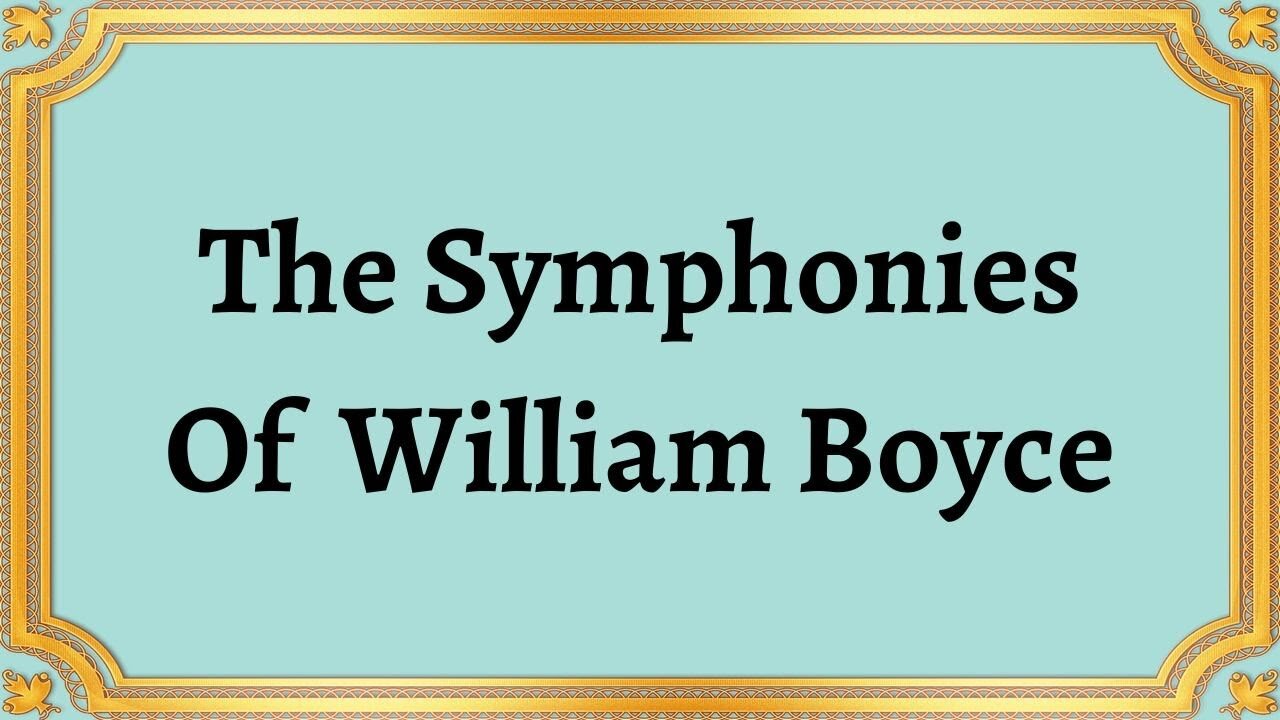Premium Only Content

The Symphonies Of William Boyce
#classicalmusic#TheZimblerSinfonietta#musicalcomposition#JosephHiramZimbler#symphony#orchestra
The Symphonies Of William Boyce
Publication date 1950
The Zimbler Sinfonietta
No 1 In B Flat Major 00:00
No 2 In A Major 08:39
No. 3 In C Major 14:04
No. 4 In F Major 19:36
No. 5 In D Major 25:42
No. 6 In F Major 33:36
No. 7 In B Flat Major 42:39
No. 8 In D Minor 52:26
The Zimbler Sinfonietta is a renowned piece of music composed by Joseph Hiram Zimbler. This musical composition consists of eight invaluable symphonies namely, No. 1 in B Flat Major, No. 2 in A Major, No. 3 in C Major, No. 4 in F Major, No. 5 in D Major, No. 6 in F Major, No. 7 in B Flat Major, and No. 8 in D Minor.
The Zimbler Sinfonietta comprises a fascinating blend of classical music, romance, and high-energy orchestral performances. The first symphony was composed in 1928, while the last symphony was composed in 1958, making the composition a product of Joseph’s musical craftsmanship over three decades.
Symphony No. 1 in B Flat Major strikes the listener with a distinct and captivating melody, making it an instant classical favorite. The symphony's instrumentation is masterfully done, with prominent violin and flute contributions, adding lightness and airiness. The piece is known to stick to traditional structures while incorporating unanticipated dynamic shifts.
Symphony No. 2 in A Major is marked by an uplifting musical dialogue between the strings and the wind instruments. It's a natural evolution of the composer's style, with excellent attention to detail and a fascinating exploration of musical themes throughout the composition.
Symphony No. 3 in C Major is a composition that displays the composer's mastery in crafting melodies that tug at the emotions of the listener. The symphony has a passionate lead melody played by the violins that is later joined by other instruments, leading to an inspiring climax that resonates with listeners.
Symphony No. 4 in F Major is characterized by its intense and fast-paced introductory movement. The composition comprises a series of lively themes that shift with breathtaking swiftness yet maintain cohesion and harmony. It features impressive string techniques, bringing out the sheer energy of the piece.
Symphony No. 5 in D Major commence with gentle, intricate string segments that contribute to the feeling of serenity and calmness. The composition then builds up to a brilliant and dynamic climax that features a fantastic display of technical prowess from the string section.
Symphony No. 6 in F Major is marked by its evocative and emotive musical statements, with a masterful interplay between the various instruments. The symphony's meandering progressions seem to invite the listener to a journey of introspection and contemplation.
Symphony No. 7 in B Flat Major is a proud member of this collection, featuring a captivating and lively melody that gives an air of optimism and hope. Its opening movement begins with a series of grandiose chords that sets a tone for the entire symphony. The symphony's unique charm lies in its ability to evoke feelings of happiness while maintaining tonality and musical nuance. The piece also displays Zimbler's ability to blend classic and thematic styles, leading to a well-coordinated and memorable finale.
Finally, Symphony No. 8 in D Minor concludes the collection and is widely regarded as one of the most sentimental and emotional pieces of music in the compilation. Zimbler invokes sadness and melancholy with the use of minor keys and musical tension. The symphony features an ethereal and angelic opening that is marked by the entrance of various instruments, with the strings taking center stage. Each movement in the symphony evokes a unique mood and feeling, with the final movement being the most serene, culminating in a satisfying and heartwarming end.
The Zimbler Sinfonietta's historical significance lies in its ability to combine traditional classical music with more contemporary sounds. Joseph Hiram Zimbler successfully crafted an oeuvre that is full of depth, nuance, and character. Each symphony in the composition has its personality and identity, yet they all come together to generate an inspiring and cohesive artistic opus.
In conclusion, The Zimbler Sinfonietta is a timeless and invaluable piece of Western music, with every symphony continuing to captivate listeners with its emotional depth and artistic finesse. The composition will continue to stand the test of time, as it underlines Joseph Hiram Zimbler's ingeniousness, his passion for music, and his dedication to his craft.
You have the opportunity to support the channel https://destream.net/live/RadSiarAl/donate
-
 34:26
34:26
Classical music_Music Inspiration
2 months agoAram Khachaturian Concerto for Violin and Orchestra
1132 -
 3:04:40
3:04:40
Danny Polishchuk
11 hours agoLiberation Day Looms + Guest Richard Syrett Talks JFK Files | Low Value Mail Live Call In Show
12.5K3 -
 2:40:15
2:40:15
Barry Cunningham
4 hours agoPRESIDENT TRUMP SIGNS NEW EXECUTIVE ORDERS AND THE EVENING NEWS!
15.6K13 -
 2:49:55
2:49:55
TimcastIRL
4 hours agoGOP Office TORCHED, Terror Suspected, Elon Says ARREST Dem Funders w/Winston Marshall | Timcast IRL
169K80 -
 1:39:42
1:39:42
Glenn Greenwald
7 hours agoMajor Escalation in Attempts to Purge U.S. Universities of Israel Critics; Who are the Israel Groups Providing Lists to the U.S. Government to Deport & Punish? | SYSTEM UPDATE #431
160K143 -
 LIVE
LIVE
SpartanTheDogg
10 hours agoPro Halo Player
461 watching -
 1:08:55
1:08:55
Donald Trump Jr.
10 hours agoGlobalist Panic & Populist Prosperity, Live with Natalie Winters & Alex Epstein | Triggered Ep229
151K97 -
 1:37:15
1:37:15
CocktailsConsoles
3 hours agoBE PART OF THE GAME!!| Death Road to Canada | Cocktails & Consoles Livestream
16.9K1 -
 1:04:29
1:04:29
BonginoReport
8 hours agoFDA Vax Pusher Needs to Look in the Mirror - Nightly Scroll w/ Hayley (Ep.16) - 03/31/2025
114K78 -
 3:27:31
3:27:31
SquallRush
1 day agoBrawlhalla Mondays!
20.8K